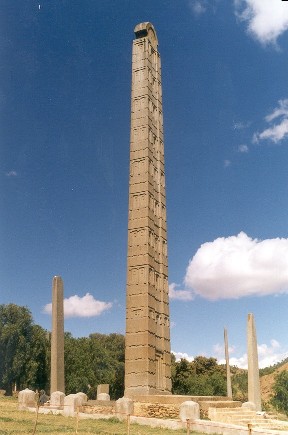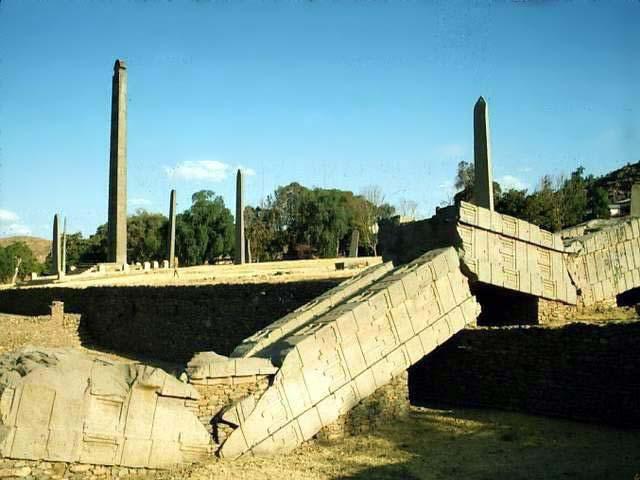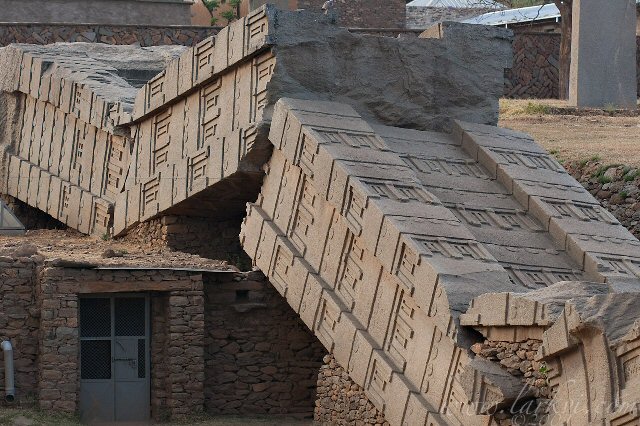|
Location: Tigray region,
Ethiopia |
Grid Reference:
14�07' N, 38�44' E. |

 The Axum Stelae:
The Axum Stelae:
The area of
Axum is home to what was once seven large stelae, all decorated
in the same style, with doors and windows and astral imagery at
the top. The largest (still standing) is 21m high (70ft) but
there were larger with the heaviest, now fallen and broken
estimated to have originally weighed in at around 500 tons.
(Ref: BBC. 'Around
the world in eighty treasures' BBC2 - 29th Nov 2007)
Axum was the
ancient political and religious capital of Ethiopia. Though the
exact date of its founding is not known, it is known that the
Queen of Sheba, who reigned around 1000 B.C. had Axum as her
royal capital. Axum was also rumoured to be the home of the Ark
of the covenant.
(1906
Map of Axum)
The kingdom of Aksum had
its own written language called Ge'ez, and also developed a
distinctive architecture exemplified by giant obelisks, the
oldest of which (though much smaller) date from 5,000-2,000
BC. (2)
The Northern Stelae Field
contains more than 120 stelae made of smooth, grey stone.
The stelae are each made from
single pieces of granite
and stand as high as 82 feet. All the Axum stelae
face south, and so
watch the sun on its daily journey across the sky.
The Stelae were
carved and erected in the city of Axum
(in modern-day Ethiopia), probably during the 4th century A.D.
by subjects of the Kingdom of Aksum, an ancient Ethiopian
civilisation. The largest of the grave markers were for royal
burial chambers and were decorated with multi-story false
windows and false doors, while nobility would have smaller, less
decorated ones. Although there are only a few large ones
standing, there are hundreds of smaller ones in various stages
of disrepair.

Over
thirty-three metres tall, the stele represents a thirteen storey
tower, with elaborate window-tracery, frames, lintels,
beam-ends, even a door with a bolt.
|
The Return of the 'Axum Obelisk': |
In 1937, the
Axum Obelisk
was
cut
into
six
sections
and
dragged
by
hundreds
of
Italian
and
Eritrean
soldiers
(for
more
than
two
months)
to
the
port
of
Massawa.
It
arrived
via
ship
to Naples (on
a
boat
called
Adua ),
on March 27 1937.
Then
it
was
transported
to
Rome,
where
it
was
reassembled
and
placed
on October 28 1937 in
Porta
Capena
square, Rome.
On
28th May 2002 an Act of God reminded Rome of the spirit of the
pillar. It was actually on the eve of the Ethiopian Independence
Day that lightning struck the obelisk on the Piazza and damaged
the tip.
One of a group of
seven obelisks erected at Axum when Ethiopia adopted Christianity
under the Emperor Ezana in the mid-fourth century A.D., the
78-foot-tall monument was taken by the occupying Italian army and
shipped to Rome in 1937 to celebrate Mussolini's fifteenth year of
power. It was erected near the Circus Maximus and stood there until
it was dismantled in 2003 following a lightning strike that had
damaged the top of the obelisk the year before.

The
obelisk was cut into three pieces in order to transport it
by back by plane and the airport was extended in order to
land the plane.

Photo of the Axum
obelisk in its original position.

Stela 'I' as it is today.
(2009).
(Menhirs
and Obelisks)
|




